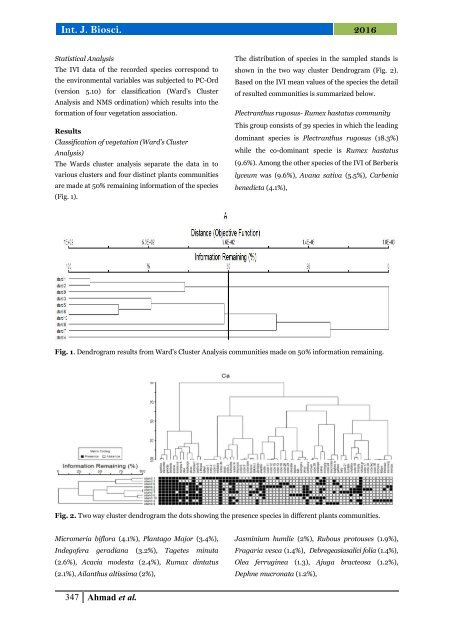Vegetation structure of Plectranthus rugosus dominated communities in Tehsil Kabal district, Swat
The present study aimed to investigate the status of Plectranthus rugosus dominated communities in Kabal swat. Various phytosociological attributes of all the recorded species were obtained. For quantitative analysis of vegetation a 4x4 m2 quadrat was used and a total of ten stands were sampled. Five quadrats were taken randomly per stand. Descriptive information altitude of the sampling site was recorded. For classification and ordination of vegetation data Ward’s Cluster Analysis and Nonmetric Multidimensional Scaling (NMS) ordination was applied using PC-Ord software which results into the formation of four communities groups at 50% remaining information of the species. The highest values IVI, density/ha and cover/ha of Plectranthus rugosus was recorded in communities’ group I while lowest value of ivi, density/ha and cover/ha was recorded in community group 3 which is due to the anthropogenic disturbance as observed during field survey.
The present study aimed to investigate the status of Plectranthus rugosus dominated communities in Kabal swat. Various phytosociological attributes of all the recorded species were obtained. For quantitative analysis of vegetation a 4x4 m2 quadrat was used and a total of ten stands were sampled. Five quadrats were taken randomly per stand. Descriptive information altitude of the sampling site was recorded. For classification and ordination of vegetation data Ward’s Cluster Analysis and Nonmetric Multidimensional Scaling (NMS) ordination was applied using PC-Ord software which results into the formation of four communities groups at 50% remaining information of the species. The highest values IVI, density/ha and cover/ha of Plectranthus rugosus was recorded in communities’ group I while lowest value of ivi, density/ha and cover/ha was recorded in
community group 3 which is due to the anthropogenic disturbance as observed during field survey.
You also want an ePaper? Increase the reach of your titles
YUMPU automatically turns print PDFs into web optimized ePapers that Google loves.
Int. J. Biosci. 2016<br />
Statistical Analysis<br />
The IVI data <strong>of</strong> the recorded species correspond to<br />
the environmental variables was subjected to PC-Ord<br />
(version 5.10) for classification (Ward’s Cluster<br />
Analysis and NMS ord<strong>in</strong>ation) which results <strong>in</strong>to the<br />
formation <strong>of</strong> four vegetation association.<br />
Results<br />
Classification <strong>of</strong> vegetation (Ward’s Cluster<br />
Analysis)<br />
The Wards cluster analysis separate the data <strong>in</strong> to<br />
various clusters and four dist<strong>in</strong>ct plants <strong>communities</strong><br />
are made at 50% rema<strong>in</strong><strong>in</strong>g <strong>in</strong>formation <strong>of</strong> the species<br />
(Fig. 1).<br />
The distribution <strong>of</strong> species <strong>in</strong> the sampled stands is<br />
shown <strong>in</strong> the two way cluster Dendrogram (Fig. 2).<br />
Based on the IVI mean values <strong>of</strong> the species the detail<br />
<strong>of</strong> resulted <strong>communities</strong> is summarized below.<br />
<strong>Plectranthus</strong> <strong>rugosus</strong>- Rumex hastatus community<br />
This group consists <strong>of</strong> 39 species <strong>in</strong> which the lead<strong>in</strong>g<br />
dom<strong>in</strong>ant species is <strong>Plectranthus</strong> <strong>rugosus</strong> (18.3%)<br />
while the co-dom<strong>in</strong>ant specie is Rumex hastatus<br />
(9.6%). Among the other species <strong>of</strong> the IVI <strong>of</strong> Berberis<br />
lyceum was (9.6%), Avana sativa (5.5%), Carbenia<br />
benedicta (4.1%),<br />
Fig. 1. Dendrogram results from Ward’s Cluster Analysis <strong>communities</strong> made on 50% <strong>in</strong>formation rema<strong>in</strong><strong>in</strong>g.<br />
Fig. 2. Two way cluster dendrogram the dots show<strong>in</strong>g the presence species <strong>in</strong> different plants <strong>communities</strong>.<br />
Micromeria biflora (4.1%), Plantago Major (3.4%),<br />
Indeg<strong>of</strong>era geradiana (3.2%), Tagetes m<strong>in</strong>uta<br />
(2.6%), Acacia modesta (2.4%), Rumax d<strong>in</strong>tatus<br />
(2.1%), Ailanthus altissima (2%),<br />
Jasm<strong>in</strong>ium humlie (2%), Rubous protouses (1.9%),<br />
Fragaria vesca (1.4%), Debregeasiasalici folia (1.4%),<br />
Olea ferrug<strong>in</strong>ea (1.3), Ajuga bracteosa (1.2%),<br />
Dephne mucronata (1.2%),<br />
347 Ahmad et al.


















